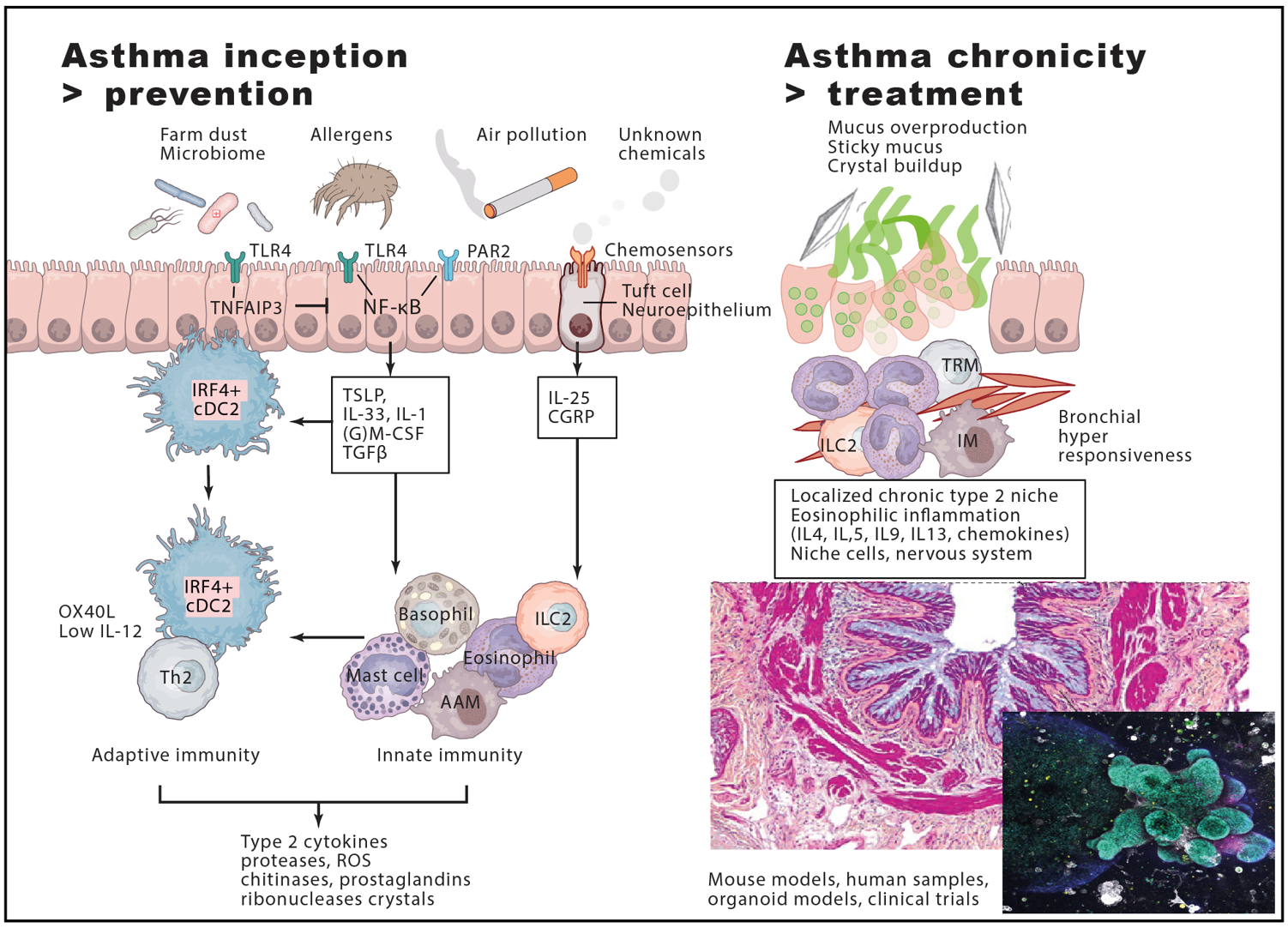

Study of the molecular mechanism of DC-epithelial interaction in asthma and how this is influenced by infection and environment
The research in our unit is centered around the role of dendritic cells and macrophages in various lung diseases such as asthma, respiratory viral infections and lung cancer. The incidence of these diseases has reached epidemic proportions, and asthma for example affects 300 million people worldwide. We focus on the traditional immunological functions of DCs and macrophages as antigen-presenting cells (APCs), but we are also known for our research on how epithelial cells and innate immune cells communicate with APCs to activate or suppress them, and in this way cause or perpetuate disease. Most of our questions are related to type 2 immune responses in asthma, viral infection and cancer. Research in our lab pioneered the critical contribution of DC and macrophage subsets in the recognition of allergens, the activation and the polarization of naïve and memory Th subsets into Th2 cells and resident memory Th2 cells. Our views on how DCs get activated in response to allergen recognition by epithelial cells have changed the way we think about mucosal immune responses in general, and have led to several new drug targets for intervention in chronic asthma, and to a conceptual framework on how we can understand the influence of age, genetics and environment on asthma risk and protection. A hot area of research is to understand how chronic asthma leads to alterations in lung structural cells and airway mucus, leading to the formation of a hyperpolarized type 2 niche, that leads to mucus plugging and severe airway remodelling.
Our ultimate goal is to find novel ways to prevent and treat lung disease. To achieve this goal we continuously develop new tools, so that we test out new concepts and tackle difficult questions in an innovative and competitive manner. For this, we have set up translational allergy models in mice and organoids, created several new lines of TCR and BCR transgenic mice that react to allergen components or to viral proteins, and created several new lines to tackle the heterogeneity and function of DCs and macrophage subsets. To achieve applicability and translation, we set up early stage collaborations with Biotech and Pharma and University Hospitals, to take our ideas to the clinic. Currently two of our fundamental research programs are progressing towards clinical stage testing in humans.
Areas of Expertise
- Lung and neonatal lung immunology
- Single cell analysis of lung cells by multicolour flow and scRNAseq, TCR and BCR repertoire analysis
- Transgenic mouse model creation (TCR and BCR transgenic, BAC transgenesis, Crispr/Cas9)
- Lung organoids
- Translational asthma research from mouse to patient
Technology Transfer Potential
- Therapeutic targets in allergic asthma
- Development of novel in vivo tools to monitor ER stress by non-invasive technologies
Selected publications
- Schuijs, M. J. et al. Farm dust and endotoxin protect against allergy through A20 induction in lung epithelial cells. Science 349, 1106-1110 (2015). Visit ➚
- Persson, E. K. et al. Protein crystallization promotes type 2 immunity and is reversible by antibody treatment. Science 364 (2019). Visit ➚
- Plantinga, M. et al. Conventional and monocyte-derived CD11b(+) dendritic cells initiate and maintain T Helper 2 cell-mediated immunity to house dust mite allergen. Immunity 38, 322–335 (2013). http://dx.doi.org/10.1016/j.immuni.2012.10.016 Visit ➚
- Bosteels, C. et al. Inflammatory Type 2 cDCs Acquire Features of cDC1s and Macrophages to Orchestrate Immunity to Respiratory Virus Infection. Immunity 52, 1039-1056 (2020). Visit ➚
- Maes, B. et al. The STE20 kinase TAOK3 controls the development house dust mite-induced asthma in mice. J Allergy Clin Immunol 149, 1413-1427 (2022). Visit ➚
Bibliography

Overview of themes in the Lambrecht-Hammad lab
External links
- VIB Grand Challenges Program - Understanding primary immune deficiencies Visit ➚
